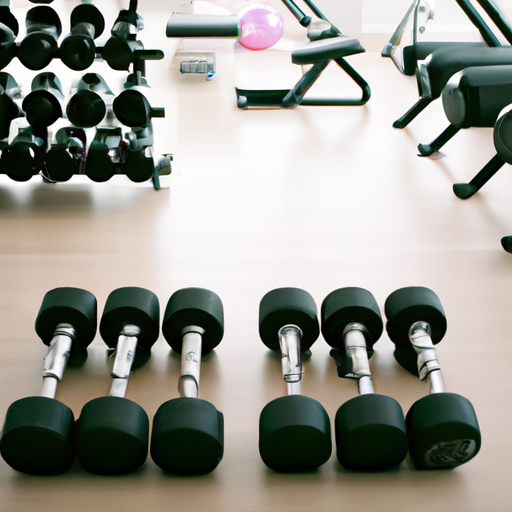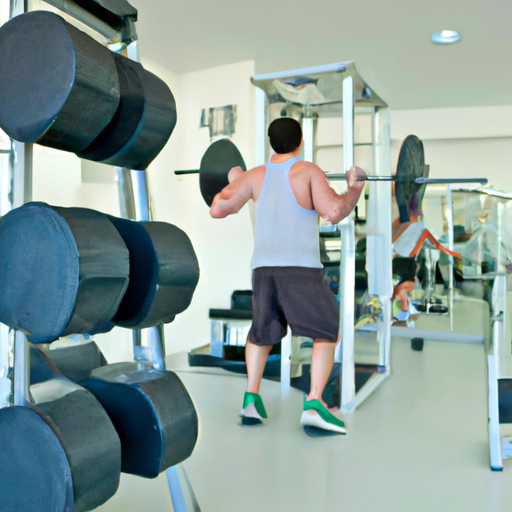If you’re someone who enjoys working out at home but the noise from your home gym is causing disturbances for others in your household, you might be wondering how you can soundproof your space to reduce the noise. Whether it’s thumping music, the clanking of weights, or the pounding of your feet on the treadmill, finding ways to minimize the sound can make your workout experience more enjoyable for everyone. In this article, we’ll explore some practical tips and tricks to help you soundproof your home gym effectively, ensuring a peaceful environment for all.

Assessing the Current Noise Levels
Before you can effectively soundproof your home gym, it’s important to assess the current noise levels. Take some time to identify the sources of noise in your gym, such as loud exercise equipment, music, or even the vibrations caused by your workout routines. By understanding where the noise is coming from, you can better determine the appropriate soundproofing solutions to implement.
Once you’ve identified the sources of noise, you’ll need to measure the noise levels in your gym. This can be done using a decibel meter, which will provide you with a numerical reading of the noise levels in your space. Take measurements in different areas of the gym to get an accurate representation of the noise levels throughout the entire room.
After measuring the noise levels, it’s important to determine the impact of the noise on neighboring areas. Consider whether the noise is noticeable or disruptive in adjacent rooms or to your neighbors if you live in an apartment or shared space. This will help you prioritize your soundproofing efforts and ensure that you address any potential issues that may arise from the noise generated in your home gym.
Soundproofing the Walls
One of the most effective ways to soundproof your home gym is by adding mass to the walls. This can be done by installing additional layers of drywall or using soundproofing materials specifically designed to increase the mass and density of the walls. The added mass helps to reduce the transfer of sound vibrations through the walls, resulting in a quieter environment.
Another option for soundproofing the walls is to use soundproof drywall. This type of drywall has sound-dampening properties built into it, allowing it to absorb and reduce noise. Soundproof drywall can be installed just like regular drywall, making it a convenient option for soundproofing your home gym.
In addition to adding mass and using soundproof drywall, consider using acoustic insulation. Acoustic insulation is designed to absorb sound vibrations and prevent them from traveling through the walls. This can significantly reduce the amount of noise that escapes the gym and is heard in neighboring areas.
To further enhance the soundproofing of your gym walls, seal any gaps or cracks. Even small gaps can allow sound to escape through the walls, so be sure to fill them with acoustic caulk or sealant. Additionally, consider using a resilient channel system, which helps to decouple the walls from the rest of the structure, minimizing the transmission of sound vibrations.
Soundproofing the Floors
When it comes to soundproofing the floors of your home gym, there are several options to consider. One effective method is to use anti-vibration pads or mats underneath heavy equipment. These pads or mats absorb vibrations and reduce the amount of noise transmitted through the floor.
Another option is to install a floating floor. A floating floor is a type of flooring that is not directly attached to the subfloor, but rather sits on top of a layer of padding or underlayment. This floating design helps to reduce the transfer of sound vibrations, resulting in a quieter space.
Adding carpet or rugs to your gym floor can also help to absorb sound and reduce noise levels. The soft fibers of the carpet or rugs act as a natural sound absorber, preventing sound from bouncing off hard surfaces and creating echoes. Additionally, consider applying sound-dampening underlayment beneath the carpet or rugs to further enhance the soundproofing properties.
For even greater soundproofing, you may want to consider using impact noise isolators. These isolators are typically made of rubber or other resilient materials and are placed between the equipment and the floor. They help to absorb and dissipate the impact noise generated during workouts, resulting in a quieter gym space.
Soundproofing the Ceiling
Soundproofing the ceiling of your home gym can be another effective way to reduce noise transmission. Installing acoustic ceiling panels can help to absorb and dissipate sound vibrations, resulting in a quieter environment. These panels are available in various sizes and designs, allowing you to choose options that not only provide soundproofing benefits but also enhance the aesthetic appeal of your gym.
Another option for soundproofing the ceiling is to use soundproofing paint. This type of paint contains sound-dampening additives that help to reduce noise levels. While not as effective as other soundproofing methods, soundproofing paint can still provide noticeable improvements in reducing the transmission of sound.
Adding mass-loaded vinyl to the ceiling can also help to further enhance the soundproofing properties. Mass-loaded vinyl is a dense material that is highly effective at blocking sound transmission. It can be installed directly over the existing ceiling or in between layers of drywall for even greater soundproofing benefits.
Applying a resilient underlayment to the ceiling can help to decouple it from the rest of the structure, reducing the transfer of sound vibrations. This underlayment is typically made of rubber or other resilient materials and helps to absorb and dissipate sound, resulting in a quieter gym space.
Consider using acoustic baffles in your gym ceiling. These baffles are suspended from the ceiling and help to absorb sound and reduce echoes. They are especially effective in larger gym spaces where sound reflections can be more pronounced.

Soundproofing the Doors and Windows
To effectively soundproof your home gym, it’s important to pay attention to the doors and windows as these are common areas for sound leakage. Start by installing solid-core doors, as they are denser and provide better sound insulation compared to hollow-core doors. The added density helps to block sound transmission and create a quieter environment.
Utilizing weatherstripping is another effective method to seal gaps and prevent sound leakage around doors and windows. Weatherstripping consists of strips of material that are applied around the edges of doors and windows to create a tight seal when closed. This helps to reduce sound transmission and keep your gym space quieter.
To further enhance the soundproofing of doors, consider using a door sweep or threshold seal. These are typically installed at the bottom of the door and create a seal when the door is closed. They help to block sound from escaping through the gap at the bottom of the door, resulting in a quieter gym environment.
Double-glazed windows are an effective option for reducing sound transmission through windows. The two layers of glass, separated by a layer of air or gas, help to block sound waves and minimize noise. If replacing your windows with double-glazed ones is not feasible, consider using window plugs or acoustic curtains to provide an additional layer of sound insulation.
Acoustic curtains can be installed over windows or dividing areas to absorb sound and reduce noise transmission. These curtains are typically made with multiple layers of dense fabric and can significantly improve the soundproofing properties of your gym space.
Vibration Isolation
Addressing vibration can be another important aspect of soundproofing your home gym. The vibrations generated from exercise equipment or vigorous workouts can transfer through the floor and walls, causing noise disturbances. To mitigate this, use vibration isolation pads or mats underneath the equipment. These pads absorb and dampen the vibrations, resulting in reduced noise transmission.
Applying vibration isolating mounts to your exercise equipment can also help to minimize the transfer of vibrations. These mounts are typically made of rubber or other resilient materials and help to absorb and isolate the vibrations, preventing them from traveling through the structure.
If feasible, consider floating or decoupling equipment from the floor or walls. This involves creating a physical separation between the equipment and the surrounding structure, such as using rubber or foam pads. Floating the equipment can effectively minimize the transfer of vibrations and reduce noise levels.
Installing rubber flooring or mats in your home gym can also help to absorb vibrations and reduce noise transmission. Rubber is a resilient material that can effectively absorb and dampen vibrations, resulting in a quieter gym environment.
Noise Reduction through Equipment
When selecting equipment for your home gym, it’s important to consider noise levels. Choose equipment that is known for its quiet operation to minimize noise disturbances. Some types of exercise machines, like elliptical trainers or rowing machines, tend to be quieter compared to others.
Using equipment mats underneath your exercise machines can also help to reduce noise. These mats absorb vibrations and provide a cushioning effect, minimizing the transfer of noise through the floor.
Inspecting and maintaining your exercise equipment regularly can also contribute to noise reduction. Loose or worn-out parts can create excessive noise during use. Keep your equipment well-maintained, tighten any loose screws or bolts, and lubricate moving parts as necessary to ensure smooth and quiet operation.
Soundproofing Ventilation and HVAC
Ventilation systems and HVAC units can contribute to noise disturbances in your home gym. To minimize this, consider installing soundproof vents or duct silencers. These devices are designed to reduce the noise generated by the airflow, resulting in a quieter ventilation system.
To further reduce noise from the ventilation system, add noise-absorbing duct lining. This lining is installed inside the ducts and helps to absorb sound vibrations, minimizing noise transmission through the system.
Using acoustic foam or panels on HVAC equipment can also help to reduce noise levels. These foam panels are designed to absorb and dampen sound, resulting in quieter operation.
Lastly, check for any sound leaks in the ventilation system. Make sure all the duct connections are secure and there are no gaps or cracks that allow sound to escape. Properly sealing the ventilation system can significantly reduce noise transmission.
Adding Acoustic Panels or Soundproof Curtains
Consider adding acoustic panels or soundproof curtains in areas where additional soundproofing is needed. Identify areas in your home gym that may benefit from the installation of acoustic panels, such as walls or ceilings that transmit a significant amount of noise. Acoustic panels are available in various types and thicknesses, so choose ones that are suitable for your gym and provide the desired level of soundproofing.
Additionally, installing soundproof curtains in windows or dividing areas can help to absorb sound and minimize noise transmission. Soundproof curtains are designed with multiple layers of dense fabric that can effectively reduce noise levels. They can be installed easily and provide a quick and temporary solution for soundproofing.
Consideration for Flooring and Wall Coverings
When selecting flooring materials for your home gym, opt for sound-absorbing options. Materials like rubber or cork can effectively absorb sound vibrations and reduce noise levels. These materials are also resilient and can withstand the impact of exercise routines, making them ideal choices for gym flooring.
Additionally, consider using textured or patterned wall coverings in your home gym. Textured or patterned surfaces help to scatter sound waves, reducing the intensity of noise. Avoid using reflective surfaces like glass or mirrors, as they can amplify sound and create echoes.
By following these comprehensive soundproofing techniques, you can effectively reduce noise in your home gym and create a quieter and more pleasant workout environment. Whether you’re exercising late at night or live in a shared space, implementing these soundproofing methods will help ensure that your workouts are not only enjoyable but also considerate of those around you.
